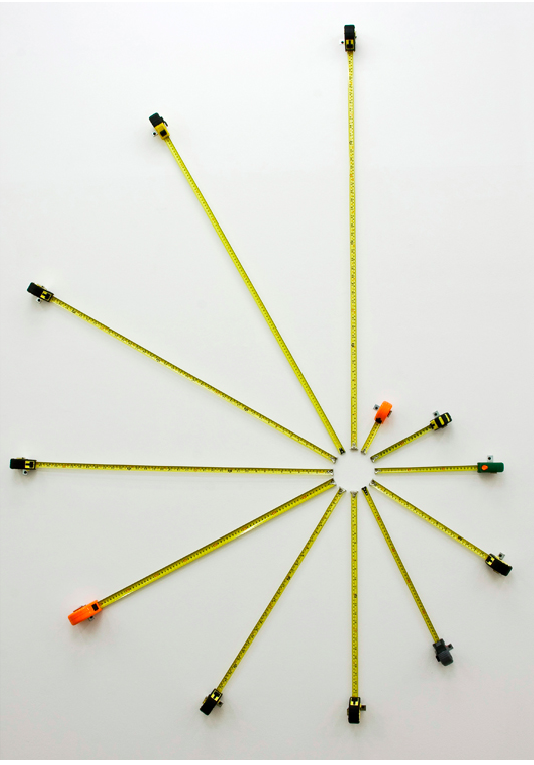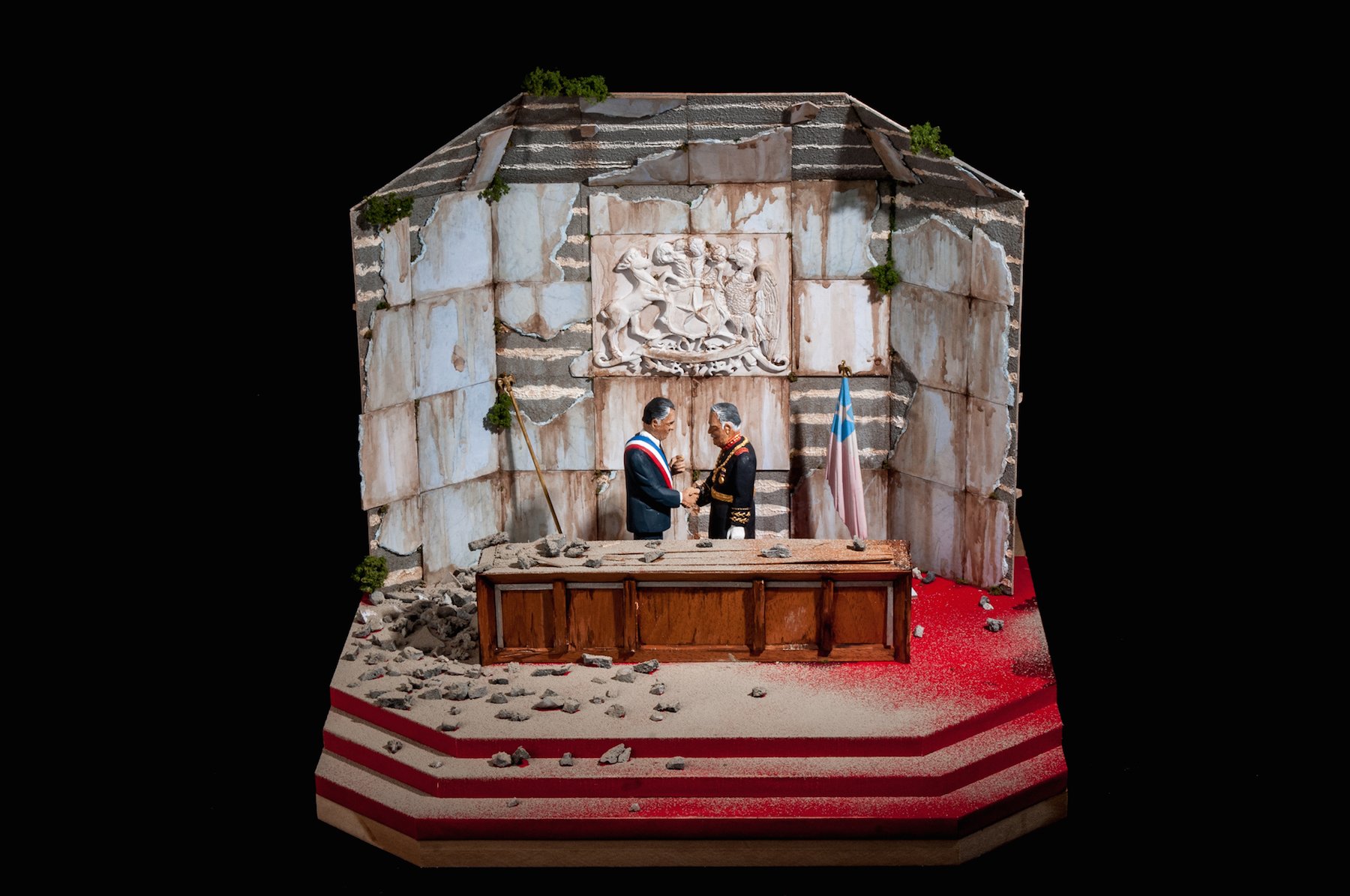
© » KADIST
Nicolás Consuegra
Consuegra’s Colombia is a mirror made in the shape of the artist’s home country—a silhouette that has an important resonance for the artist. Consuegra’s mirrored Colombia is similar to an earlier version, made to be show opposite a mirror of the United States. Whether reflecting his two homes within one another (Consuegra studied in the US and has made several works about this experience of living in exile from his homeland), or simply reflecting its surroundings, Colombia is a simple yet evocative work about the identity of a nation, and the things that we project—really and metaphorically—onto its form.

© » KADIST
Nicolás Consuegra
A residency program in the blazing hot city of Honda, Colombia, inspired artist Nicolás Consuegra to consider the difficulty in understanding the needs of a distant community. An important town during the colonial era as the main port on the Magdalena River, Honda is presently rife with poverty, unemployment, and environmental deterioration. Here he produced the work Nadie sabe de la sed con que otro bebe (No one knows the thirst with which another drinks) , a variable arrangement of cut glasses in front of a mirror so that they appear whole.

© » KADIST
Nicolás Consuegra
In his project Instituto de Vision (2008), Consuegra investigates how modernism gave rise to many new technological forms of vision, most notably the camera, yet also resulted in the disappearance of outmoded forms of vision. As a metaphor for this process, he looks to the afterlife of the image as evidenced in signs. When a company goes out of business or moves, their sign often lingers and slowly fades creating a ghosted image of their sojourn.

© » KADIST
Nicolás Grum
El gran pacto de Chile (The Great Pact) and La balserita de Puerto Gala (The Raft) were part of the “Museo Futuro”, an exhibition in which the artist presented nine miniature dioramas staging fragments of Chile’s history, from its colonial invasions to the present. Through the episodes he chose to depict, the artist focused on historical narratives, the way the story is told, and the supposed irrefutability of historical facts. Museo Futuro (“Future Museum”) stands within a tradition of artists who re-read history and offer their interpretation of it through the distopic lens of the museum display.

© » KADIST
Nicolas Bacal
Nicolás Bacal uses everyday materials to evoke systems in his sculptures and installations. He often employs and alters clocks, using them as metaphors for human relationships. Light Years (2008) consists of 12 measuring tapes of different lengths, radiating out elliptically from a central mounting point on the wall.

© » KADIST
Nicolás Paris
Nicolas Paris studied architecture and worked as an elementary school teacher before he decided to become an artist. Both of those interests feed deeply into his artistic practice, which ranges from workshops, dialogues, and exchanges to environments, drawings, and sculpture. Metaphors of the presence or conversations at the speed of light (2012) is a sculpture of a lightbulb that the artist altered.

© » KADIST
Nicolás Grum
El gran pacto de Chile (The Great Pact) and La balserita de Puerto Gala (The Raft) were part of the “Museo Futuro”, an exhibition in which the artist presented nine miniature dioramas staging fragments of Chile’s history, from its colonial invasions to the present. Through the episodes he chose to depict, the artist focused on historical narratives, the way the story is told, and the supposed irrefutability of historical facts. Museo Futuro (“Future Museum”) stands within a tradition of artists who re-read history and offer their interpretation of it through the distopic lens of the museum display.

© » KADIST
Nicholas Buffon
A series of works from 2016 document his neighborhood, replicating buildings and businesses he frequents within four blocks of his New York apartment. Made out of foam, paper, glue, and paint, these miniaturized buildings (a bank, a bar, a Laundromat, and the Rite Aid building where Buffon shops) impart a tenderness and a nostalgia that outsizes their diminutive scale. Like works by other artists who recreate objects or elements from their everyday life, Buffon’s storefronts are perfectly imperfect, the wobbled lines reiterating their handmade quality.
![A World Undone [Protolith]](https://kadist.org/wp-content/uploads/2017/11/IMG_Installation-view-3_WEB.jpg)
© » KADIST
Nicholas Mangan
Executed in 2012, A World Undone revolves around a single, metaphorically rich substance, drawing on geological research into an ancient mineral, Zircon, unearthed in remote Western Australia. These rocks are now studied, like a time capsule, revealing intriguing clues about the state of the planet more than 4 billion years ago. Mangan procured a sample of the material and reduced it to a fine dust that he then filmed, in flux, with a high-speed video camera.
Nicholas Buffon
Working in paint, performance, and small, diorama-like wall sculptures, Seattle transplant Nicholas Buffon responds to his context through intimate gestures, examinations, and recreations...
-
2000-2009
Nicolás Consuegra
2008In his project Instituto de Vision (2008), Consuegra investigates how modernism gave rise to many new technological forms of vision, most notably the camera, yet also resulted in the disappearance of outmoded forms of vision...
Nicolas Bacal
2008Nicolás Bacal uses everyday materials to evoke systems in his sculptures and installations...
-
2010-2019
Nicolás Consuegra
2012A residency program in the blazing hot city of Honda, Colombia, inspired artist Nicolás Consuegra to consider the difficulty in understanding the needs of a distant community...
Nicolás Paris
2012Nicolas Paris studied architecture and worked as an elementary school teacher before he decided to become an artist...
Nicholas Mangan
2012Executed in 2012, A World Undone revolves around a single, metaphorically rich substance, drawing on geological research into an ancient mineral, Zircon, unearthed in remote Western Australia...
Nicolás Consuegra
2014Consuegra’s Colombia is a mirror made in the shape of the artist’s home country—a silhouette that has an important resonance for the artist...
Nicolás Grum
2014El gran pacto de Chile (The Great Pact) and La balserita de Puerto Gala (The Raft) were part of the “Museo Futuro”, an exhibition in which the artist presented nine miniature dioramas staging fragments of Chile’s history, from its colonial invasions to the present...
Nicolás Grum
2014El gran pacto de Chile (The Great Pact) and La balserita de Puerto Gala (The Raft) were part of the “Museo Futuro”, an exhibition in which the artist presented nine miniature dioramas staging fragments of Chile’s history, from its colonial invasions to the present...
Nicholas Buffon
2016A series of works from 2016 document his neighborhood, replicating buildings and businesses he frequents within four blocks of his New York apartment...